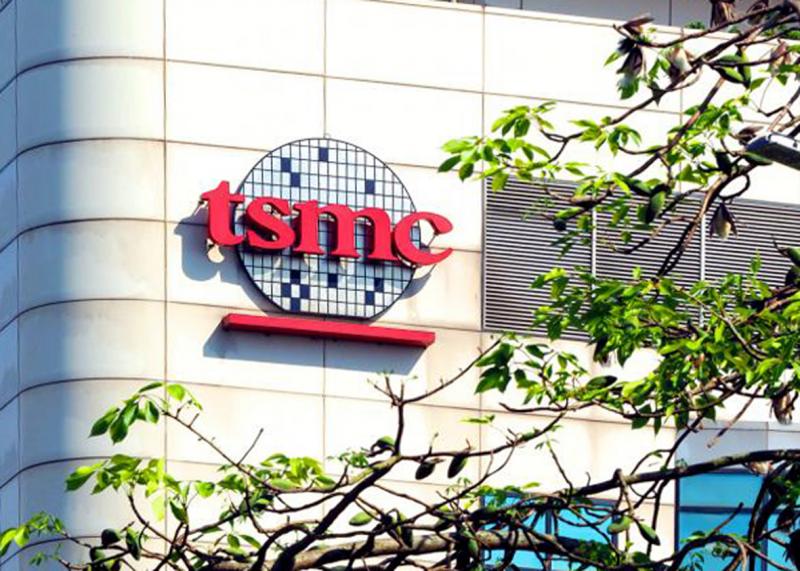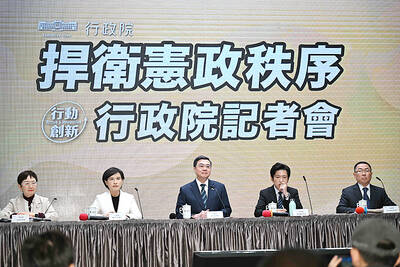Taiwan Semiconductor Manufacturing Co (TSMC, 台積電) yesterday said it is to open a new cutting-edge research-and-development (R&D) center in Hsinchu next year to develop 2-nanometer (nm) technology to secure its technology leadership.
The world’s biggest contract chipmaker said it is also seeking to acquire land adjacent to the new R&D center to build a production fab for 2-nanometer chips.
This is the first time that TSMC has disclosed details about its plans to move into 2-nanometer technology.

Photo: David Chang, EPA-EFE
The company has invested heavily in R&D and advanced capacity, offering 7-nanometer chips in 2018 and 5-nanometer chips this year, with plans to commence volume production of 3-nanometer chips in the second half of 2022, to maintain its edge over competitors such as Samsung Electronics Co.
The 2-nanometer chips are one generation more advanced than 3-nanometer ones.
The new R&D center, dubbed TSMC’s “Bell Lab,” is to house 8,000 scientists and engineers to develop next-generation chip technologies, TSMC senior vice president Kevin Zhang (張曉強) yesterday told an online technology symposium.
It is to be composed of two R&D sections — R1 and R2 — and one office building, the company said.
R1 is under construction and is to become operational next year, Zhang said.
It will serve as the base for TSMC to explore 2-nanometer technology and future generation technologies, TSMC senior vice president Y.P. Chin (秦永沛) said.
TSMC has spent more than US$10 billion a year on expanding advanced technology capacity over the past few years to meet customers’ demand, Chin said.
The investment allowed TSMC to increase its advanced technology capacity at a compound annual growth rate of 28 percent from 2016 to this year, he said.
To cope with robust demand, the chipmaker has continued to expand its 7-nanometer technology capacity, which is expected to be 3.5 times bigger than when it introduced the technology in 2018, Chin said.
The 5-nanometer technology capacity is forecast to grow 1.8 times in 2022, compared with this year’s capacity, he added.
To date, TSMC has shipped more than 1 billion 7-nanometer chips, the company said.
“If you have a 5G phone, most likely the phone is powered by TSMC’s 7-nanometer chips,” Zhang said.
As semiconductor technology is evolving rapidly and becoming increasingly complex, TSMC has been boosting R&D spending to ensure it is able to offer the most advanced technologies to its clients now and for the years to come, Zhang said.
The chipmaker spent US$2.96 billion on R&D last year, up 3.86 percent from 2018, Chang’s presentation showed.
Its R&D headcount also rose to 5,901 last year from 5,609 in 2018, it showed.
Tainan is a major manufacturing hub for the company’s advanced technologies.

The US government has signed defense cooperation agreements with Japan and the Philippines to boost the deterrence capabilities of countries in the first island chain, a report by the National Security Bureau (NSB) showed. The main countries on the first island chain include the two nations and Taiwan. The bureau is to present the report at a meeting of the legislature’s Foreign Affairs and National Defense Committee tomorrow. The US military has deployed Typhon missile systems to Japan’s Yamaguchi Prefecture and Zambales province in the Philippines during their joint military exercises. It has also installed NMESIS anti-ship systems in Japan’s Okinawa

‘WIN-WIN’: The Philippines, and central and eastern European countries are important potential drone cooperation partners, Minister of Foreign Affairs Lin Chia-lung said Minister of Foreign Affairs Lin Chia-lung (林佳龍) in an interview published yesterday confirmed that there are joint ventures between Taiwan and Poland in the drone industry. Lin made the remark in an exclusive interview with the Chinese-language Liberty Times (the Taipei Times’ sister paper). The government-backed Taiwan Excellence Drone International Business Opportunities Alliance and the Polish Chamber of Unmanned Systems on Wednesday last week signed a memorandum of understanding in Poland to develop a “non-China” supply chain for drones and work together on key technologies. Asked if Taiwan prioritized Poland among central and eastern European countries in drone collaboration, Lin

NO CONFIDENCE MOTION? The premier said that being toppled by the legislature for defending the Constitution would be a democratic badge of honor for him Premier Cho Jung-tai (卓榮泰) yesterday announced that the Cabinet would not countersign the amendments to the local revenue-sharing law passed by the Legislative Yuan last month. Cho said the decision not to countersign the amendments to the Act Governing the Allocation of Government Revenues and Expenditures (財政收支劃分法) was made in accordance with the Constitution. “The decision aims to safeguard our Constitution,” he said. The Constitution stipulates the president shall, in accordance with law, promulgate laws and issue mandates with the countersignature of the head of the Executive Yuan, or with the countersignatures of both the head of the Executive Yuan and ministers or

CABINET APPROVAL: People seeking assisted reproduction must be assessed to determine whether they would be adequate parents, the planned changes say Proposed amendments to the Assisted Reproduction Act (人工生殖法) advanced yesterday by the Executive Yuan would grant married lesbian couples and single women access to legal assisted reproductive services. The proposed revisions are “based on the fundamental principle of respecting women’s reproductive autonomy,” Cabinet spokesperson Michelle Lee (李慧芝) quoted Vice Premier Cheng Li-chiun (鄭麗君), who presided over a Cabinet meeting earlier yesterday, as saying at the briefing. The draft amendment would be submitted to the legislature for review. The Ministry of Health and Welfare, which proposed the amendments, said that experts on children’s rights, gender equality, law and medicine attended cross-disciplinary meetings, adding that